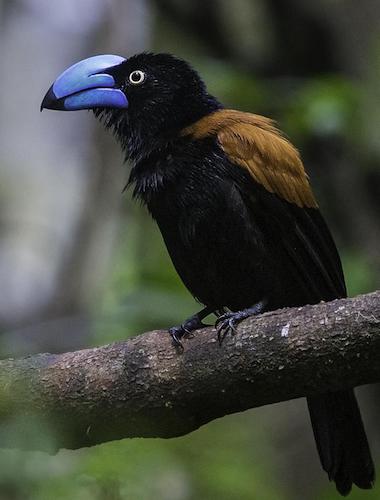Vangidae – Vangas

The Vangidae or vangas are a group of little-known small to medium-sized passerines restricted to Madagascar and the Comoros. There are about 21 species, depending on taxonomy. Most species are shrike-like, arboreal forest birds, feeding on reptiles, frogs and insects. Several other Madagascan birds more similar to Old World warblers, Old World babblers or Old World flycatchers are now often placed in this family. Vangas differ greatly in bill shape and have a variety of foraging methods. Their stick nests are built in trees. They do not migrate.
The vangas are an example of adaptive radiation, having evolved from a single founding population into a variety of forms adapted to various niches occupied by other bird families in other parts of the world. They differ in size, colour and bill shape but are similar in skull shape and bony palate structure.[9] They are small to medium-sized birds, varying from 12cm to 32cm in length. Many have strong, hooked bills similar to those of shrikes. The Helmet Vanga has a particularly large bill with a casque on top. Other species, such as the newtonias, have a small, thin bill. The Sickle-billed Vanga is notable for its long, curved bill used to probe into holes and cracks.
Most vangas are largely black, brown or grey above and white below. Exceptions include the blue and white Blue Vanga and the blue-grey Nuthatch Vanga. The Helmet Vanga is mostly black with a rufous back. Male Bernier’s Vangas are entirely black while the females are brown. It is one of several species with distinct male and female plumage while in other species the sexes are identical. Most vangas have whistling calls.
All vangas are endemic to Madagascar apart from the Blue Vanga, which also occurs in the Comoros on Mohéli island and, at least formerly, on Grande Comore. They are found throughout Madagascar, in a variety of forest and scrub habitats. Several species including Van Dam’s Vanga and Sickle-billed Vanga can be found in the dry deciduous forests in the west of the island. Some such as Crossley’s Babbler, Helmet Vanga and Bernier’s Vanga are restricted to rainforest in the east of the island. Lafresnaye’s Vanga and the recently discovered Red-shouldered Vanga occur in subarid thorn scrub in the south-west.
Their diet can include insects, earthworms, millipedes, lizards and amphibians. TheBlue Vanga and Chabert Vanga occasionally eat fruit.Many species feed in small groups, often in mixed-species foraging flocks. The Hook-billed Vanga and Lafresnaye’s Vanga tend to forage alone. Vangas have a variety of different foraging strategies. Many species glean food as they move through the branches. The nuthatch vanga climbs up trunks and branches like a nuthatch but does not climb downwards as nuthatches do. Crossley’s Babbler forages by walking along the forest floor amongst the leaf litter.[10] The Chabert Vanga and the Tylas Vanga often fly into the air to catch prey. The three Xenopirostris vangas use their laterally flattened bills to strip bark off trees to search for food underneath.
Most species nest in pairs, building cup-shaped nests using twigs, bark, roots and leaves. The Sickle-billed Vanga nests in groups and builds a large nest of sticks.
Following DNA sequencing there are now thought to be 21 species in the family Vangidae, or Vangas. They are all confined to Madagascar and neighbouring islands. They are listed below.
Red-tailed Vanga Calicalicus madagascariensis
Red-shouldered Vanga Calicalicus rufocarpalis
Hook-billed Vanga Vanga curvirostris
Lafresnaye’s Vanga Xenopirostris xenopirostris
Van Dam’s Vanga Xenopirostris damii
Pollen’s Vanga Xenopirostris polleni
Sickle-billed Vanga Falculea palliata
White-headed Vanga Artamella viridis
Chabert Vanga Leptopterus chabert
Blue Vanga Cyanolanius madagascarinus
Rufous Vanga Schetba rufa
Bernier’s Vanga Oriolia bernieri
Helmet Vanga Euryceros prevostii
Tylas Vanga Tylas eduardi
Nuthatch Vanga Hypositta corallirostris
Dark Newtonia Newtonia amphichroa
Common Newtonia Newtonia brunneicauda
Archbold’s Newtonia Newtonia archboldi
Red-tailed Newtonia Newtonia fanovanae
Ward’s Flycatcher Pseudobias wardi
Crossley’s Babbler Mystacornis crossleyi
-
Blue Vanga Cyanolanius madagascarinus
Species AccountSound archive and distribution map. -
Blue Vanga Cyanolanius madagascarinus
Species AccountThe blue vanga (Cyanolanius madagascarinus) is a bird species in the family Vangidae. -
Chabert's Vanga Leptopterus chabert
Species AccountThe chabert vanga (Leptopterus chabert), also erroneously called "Chabert's vanga", is a species of bird in the family Vangidae. It is monotypic within the genus Leptopterus. -
Chabert's Vanga Leptopterus chabert
Species AccountThe spiny forest of southwestern Madagascar is one of the world's strangest habitats, dominated by tall, spiky Alluaudia procera trees. -
Chabert's Vanga Leptopterus chabert
IUCN Species Status -
Chabert's Vanga Leptopterus chabert
Species AccountSound archive and distribution map. -
Roufous Vanga Schetba rufa
Species AccountSound archive and distribution map. -
Roufous Vanga Schetba rufa
Species AccountThe rufous vanga (Schetba rufa) is a species of bird in the Vangidae family. It is monotypic within the genus Schetba. -
Sickle-billed Vanga Falculea palliata
Species AccountSound archive and distribution map. -
Sickle-billed Vanga Falculea palliata
Species AccountThe sickle-billed vanga (Falculea palliata) is a species of bird in the vanga family Vangidae. It is monotypic within the genus Falculea. It is endemic to Madagascar. Its natural habitats are tropical dry forests and tropical dry shrubland.
-
Number of bird species: 21
